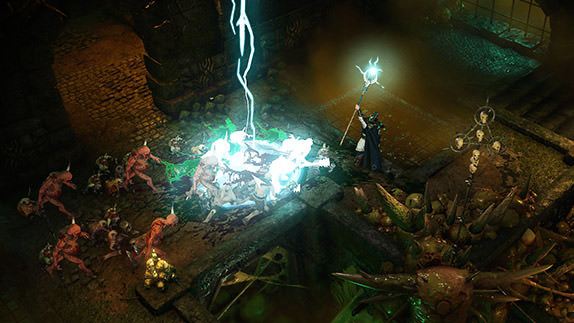The Last Tinker: City of Colors Review

 By Kevin Mitchell
Posted on September 4, 2014
By Kevin Mitchell
Posted on September 4, 2014
Tinkerworld’s brightly colored residents have a problem, namely each other, and it is up to Koru to bring the peace back to the cardboard world. Unlike the others, Koru has ape-like features, and has a mysterious aura surrounding him. In the past everyone (and every color) lived in harmony, but now each of the colors have divided Colortown into separate colored districts. Trust me, you don’t want to find yourself on the wrong side of the brightly colored red district late at night. When the white goo known as The Bleakness starts to blanket Colortown, Koru must bring color back to the world with the help of the Color Spirits.
Instead of voice acting, each of the creatures and citizens of Colortown produce unique sound effects that feels inspired from the classic Nintendo 64 title Banjo-Kazooie. As you read the dialogue, you’ll smile at the small touches in the game, such as using word balloons for the characters that are made out of cardboard and even the environments feel straight out of cardboard diorama. I appreciate the stylized visuals, relying on the use of design and color. The audio however doesn’t stand up, as some of the sound effects felt like nails on a chalkboard. When I had to collect countless crystals in the game, I turned down the volume, as the thought of hearing the crates breaking every couple of seconds made my eye start to twitch.
As you locate the Color Spirits, you’ll gain new abilities that will help you combat The Bleakness. Initially you aren’t able to use any of your combat moves on the roaming bodies of Fluff, as a single touch will fade the color right off Koru’s body, but the use of the Color Spirits will allow you to defend yourself. The combat in the game feels similar to the widely popular combat mechanics from the Batman: Arkham series, although simplified for a younger target audience. Most of the time you’ll find yourself timing your punches, charge attacks and dodges to avoid incoming attacks. An indicator lets you know exactly who is attacking, allowing you to dodge with relative ease. Unlike Batman, where you can find yourself overwhelmed, The Last Tinker’s deliberately slower pace may be a turn off for those looking for a challenge. You’ll gain special abilities through the help of the Color Spirits, but you’ll still be using your basic combat for the majority of your attacks.
Although The Last Tinker was originally a PC game released last year, the PlayStation 4 version of the game doesn’t run as smooth as I would have hoped. Anytime the camera pans to open areas (which is frequent), the game will begin to chug, dipping well below acceptable standards. During the tedious opening hours of the game, Koru must collect a set amount of crystals as his entry fee into a race. To learn the basics of the game, you undertake a couple of fetch quests that reward you with enough crystals to start the race. In fact, the next quest you are given upon completion is to enter the race! As it turns out, I ended up 100+ crystals short of what was needed. Apparently even though I collected them from one of the quests, it failed to register upon exiting the game. To earn the needed amount of crystals, I spent two hours going back and forth through different areas of the game, punching boxes and collecting crystals one at a time.
The Last Tinker is a platformer at heart, and you’ll be spending most of your time traversing the environment, trying to get to the next area. Similar to the Assassin Creed series, holding the run button allows you to jump over gaps, climb up ropes, make your way across monkey bars, and even hop from from one platform to another automatically. The early parts of the age have you leaping from octopus tentacles as they protrude from the water, trying to make it to the other side before the tentacles retract back under water. The fastest mode of travel is rail grinding, with only wooden barriers blocking your path which can easily be jumped over. Paint brushes are the game’s only hidden items to collect. You’ll find them tucked away in corners or hidden behind a group of crates.
There are also basic puzzle sections, allowing you to control two mindless characters by whistling as well as a stealth level, helping to add variety to the game.
Simply Put
I almost wrote off The Last Tinker within the first couple hours of the game, mostly due to the bug that forced an additional two hours to the beginning of the game. There are redeemable concepts in The Last Tinker, but the entire experience is married by mediocre combat and disappointing audio.
Note: The Last Tinker: City of Colors was reviewed on PlayStation 4. A digital copy of the game was provided by the publisher/developer.




